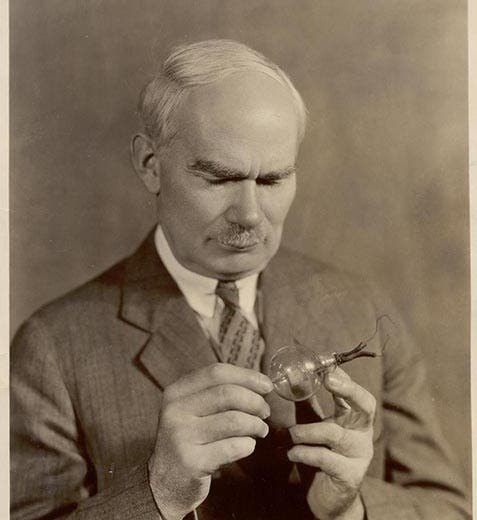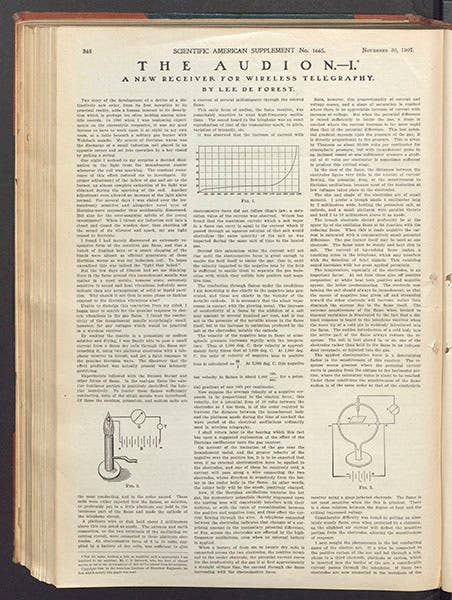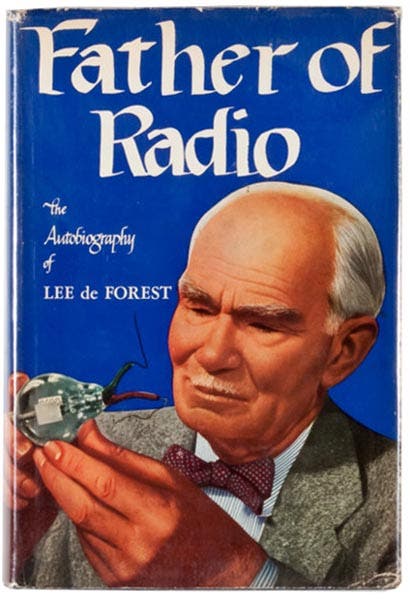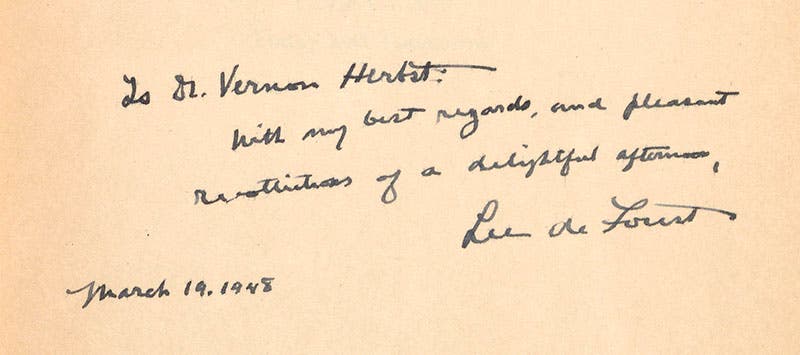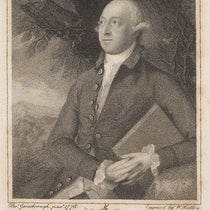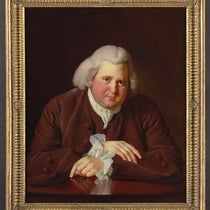Scientist of the Day - Lee de Forest
Lee de Forest, American physicist and inventor, was born August 26, 1873. His father, Henry de Forest was a Congregationalist minister, who hoped that his eldest son might follow in his footsteps by becoming a man of the cloth. Lee, however, found mathematics and science more appealing than Greek or Latin. When the time came to attend college, he successfully applied to his father’s alma mater, Yale University but broke from family tradition by enrolling in the Sheffield Scientific School rather than pursuing a classical education. From the moment he arrived in New Haven, De Forest displayed an entrepreneurial streak, proposing an array of potentially lucrative inventions ranging from a chainless bicycle to an underground trolley system. Later, inspired by the example of Nikola Tesla, he became fascinated with the practical uses of electricity. After completing his undergraduate coursework, he studied electrical theory with Yale theoretician Josiah Willard Gibbs and completed a doctoral thesis that expanded upon Heinrich Hertz’s successful efforts to transmit electromagnetic waves. De Forest had dreamed of working for Tesla or his Italian rival, Guglielmo Marconi—two men on the forefront of wireless communication research. After neither of those men responded to his letters, he found a job in Chicago, working in the dynamo department of Western Electric Company. While there, he continued his wireless research, focusing his efforts upon the development of improved wireless receivers. By 1902, he felt confident enough in his efforts to start his own business, establishing the De Forest Wireless Telegraph Company. His main partner in this enterprise was a financial speculator named Abraham White, who saw De Forest’s radio experiments as a pathway to fame and fortune. Working together, White and De Forest engaged in a series of publicity stunts to win over potential investors. In February 1903, for example, they parked a car with a small wireless station near Wall Street and transmitted the latest stock market quotations. The following year they caused a stir at the St. Louis World’s Fair by constructing a 300-foot-tall steel tower where De Forest, whose name was spelled out in lights on the side, could conduct his wireless experiments (second image).
Despite its growing public prominence, the De Forest Company was ultimately a commercial failure. Abraham White’s enthusiasm for public relations led him to issue increasingly exaggerated claims about the capabilities of De Forest’s equipment. De Forest also contributed to the company’s poor fortunes, since his wireless system relied heavily on a signal detector that was nearly identical to one previously developed by Canadian inventor Reginald Fessenden. When Fessenden sued the De Forest Company for patent infringement, White cut ties with the firm’s namesake in 1906, absconding with the company’s assets and the rights to nearly all of De Forest’s inventions. Devastated by his financial misfortunes, De Forest threw himself back into his research, returning once again to radio reception. Building upon the work of British engineer John Ambrose Fleming, he modified a light bulb, inserting a small metal plate next to the filament. Fleming had already shown that such a device acted like a valve, permitting the flow of current in only one direction (from the filament to the plate) and that such a device could be used to convert oscillating radio waves into direct current signals that could be heard through earphones. De Forest made two minor changes to Fleming’s design. First, where Fleming had applied power to just the filament, De Forest recommended connecting batteries to both the filament and the plate. More importantly, De Forest did not create a vacuum in the tube, believing that the flow of current inside depended upon the presence of ionized gases. When he unveiled his invention at an October 1906 meeting of the American Institute of Electrical Engineers, De Forest referred to it as an “audion,” a portmanteau of “audio” and “ionized” (third image).
In this initial form, De Forest’s audion was essentially nothing more than a slightly modified Fleming valve. The following month, however, De Forest took an additional step that finally earned him the fame that he had always sought. His breakthrough was the addition of a small, zig-zagging piece of wire, which he referred to as a “grid,” between the plate and the filament. This seemingly minor modification allowed the audion to not merely detect radio signals but to amplify them as well. While he was uncertain how it accomplished this task, De Forest submitted a patent for his new three-element audion tube, or “triode,” in January 1907 (fourth image).
The success of the audion enabled De Forest to remain involved in the radio industry, and he proceeded to organize some of the earliest public broadcasts, including a 1910 live performance by Enrico Caruso from the stage of the Metropolitan Opera. He did not, however, devote time to unraveling exactly how the triode tube worked. A full theoretical explanation for the audion arrived in 1913, thanks to the efforts of a young electrical engineer named Edwin Armstrong. Armstrong, a student at Columbia University, confirmed that contrary to De Forest’s initial theories, the audion’s operation did not rely on ionized gases. He also demonstrated that by feeding the incoming signal on the plate back into its grid, he could not only amplify signals but also generate continuous radio waves capable of carrying the human voice. (Previous efforts to transmit speech, including De Forest’s, had relied upon massive alternating-current generators to produce signals of suitably high frequency.) De Forest was thrilled at the growing importance of the audion and other vacuum tubes in the development of modern electronics, but he loathed the notion of sharing credit for his invention with Armstrong. When the younger engineer attempted to patent his new “regenerative circuit,” De Forest filed suit claiming that he had actually devised the idea first. The resulting legal battle between De Forest and Armstrong lasted from 1914 to 1934. Finally, at the end of two decades the Supreme Court ruled that, on the basis of a 1912 lab notebook entry, De Forest had indeed created a regenerative circuit earlier than Armstrong, even if he did not recognize its significance or file a patent application at the time. De Forest reveled in the Supreme Court’s findings. While the electrical engineering community rallied around Armstrong, De Forest vigorously defended his status as the man who had not only invented the audion but unlocked its technological potential (first image). Even after setting aside wireless research to pursue other innovations, most notably Phonofilm (an early attempt to add sound to motion pictures), De Forest continued to identify himself as the “Father of Radio,” even choosing that phrase as the title of his 1950 autobiography (fifth image).
The Linda Hall Library owns an autographed copy of Father of Radio, which until recently was shelved in our general collections. It has been since been moved into our rare book room, along with a signed copy of his 1942 book, Television: Today and Tomorrow, the latter of which contains an inscription to Dr. Vernon Herbst (sixth image), a Hollywood psychiatrist whose clientele included stars like Greta Garbo. Both of these volumes were generously donated to the Library by James P. Rybak.
Further information about the early history of radio, with a specific focus on Lee de Forest, Edwin Armstrong, and RCA chairman David Sarnoff, can be found in Tom Lewis’s book, Empire of the Air: The Men Who Made Radio, or Ken Burns’s documentary of the same name. Benjamin Gross, Vice President for Research and Scholarship, Linda Hall Library. Comments or corrections are welcome; please direct to grossb@lindahall.org.

